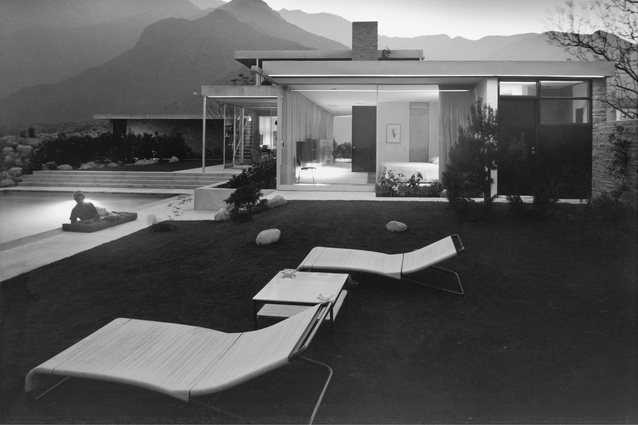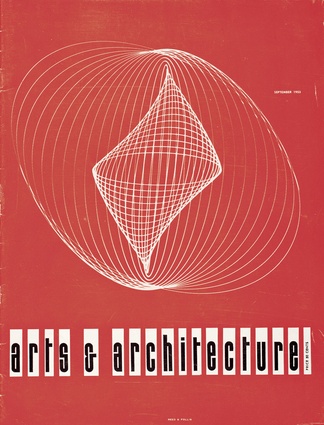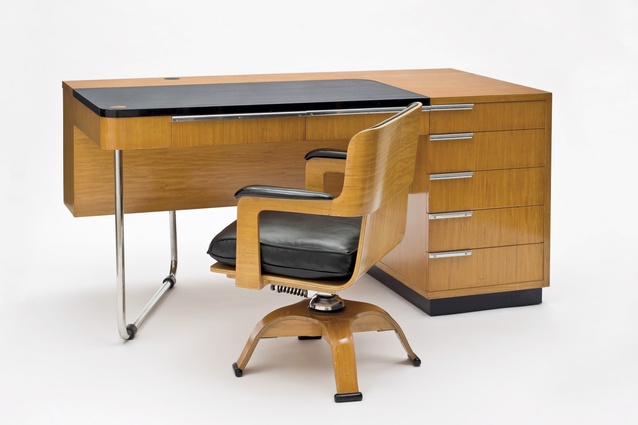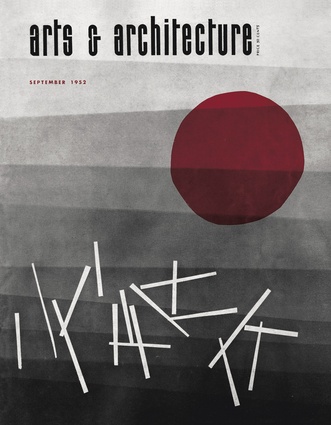Californian confidence
Look out for the famous Julius Shulman photograph of the Stahl House in this show. It’s an image stolen by a dozen films. The glazed living room cantilevers out of the Hollywood hillside while, far below, the lights of Los Angeles stretch a net into the desert. Two women sit in the glass corner of the room in half light. The promise of California is as winning and insistent as is a purring cat on a pool patio.
The Stahl House was designed by Pierre Koenig – number 22 of Arts & Architecture magazine’s Case Study Houses. One day in 1995, a few architects from Auckland bowled up there unannounced and told Mr Stahl, through the intercom outside his gated community, that they’d come all the way from New Zealand to see his house in the Hollywood hills. “Well, come on up!” he said and a few moments later they and, more importantly, I entered through his carport straight into his private court. Ahead lay the fabled living room which we approached across ‘floating’ slabs over a pool, in front of a curtained bedroom in which, it transpired, Mrs Stahl was lying. First lesson: electronic admission and Californian confidence can put you poolside, and even bedside, before you reach the front door. Buck Stahl was a bluff, straight-talking engineer. He told us, “I worked out the house design and then got Pierre to draw it up.” Déjà vu for the visitors. That night I stayed with old friend, film director Roger Donaldson. “I know that house.
I shot a film there”, he said. I enjoyed Stahl’s eye for the dollar.
Years earlier, I had seen the Eames House and marvelled at what looked like a piece of the Australian bush, with a path of railway sleepers beside a 3D Mondrian. In Pacific Palisades, irrigation has greened the verges and the air is scented with foliage: except at the Eames House, where a patch of desert remains. Shulman’s interior shot in this show catches the ethic and aesthetic of the Eames couple. There are Charles and Ray, sitting in a world that is entirely and wonderfully designed. Not just their house – spare, nearly prefab, artful – but every artefact around them: furniture, rugs, knick-knacks, every damned thing. How happy they would be that their $1,000 dining chairs now come, not from Knoll, but from China to Nood shops for $250. At least mass production encouraged copying. The Case Study Houses never became models for American suburban life any more than Group Architects’ houses in New Zealand won over the mass builders here.
A hundred metres away from the Eames House is a timber Neutra house and the Soriano house of John Entenza, the editor of Arts & Architecture magazine, who masterminded the whole Case Study House programme. When I saw it, his house was a relic, dirty and abandoned, but I remember thinking that a dust-covered, once-white, padded, sunken seating square may have been the first ‘conversation pit’: a harbinger of 1970s’ desire.
In the California Design show, architecture is pictures and not very big ones. Everything else – lamp, chair, dress – is real, and well worth contemplating. We take for granted these days that pictures of buildings will do but, of course, they won’t. Anyone who is really interested in Californian architecture can visit the buildings in this show, just by bowling up or emailing the tour guides.
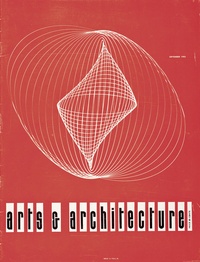
Arts & Architecture magazine was highbrow. The popular version of Californian architecture was published in America by Sunset magazine and read by New Zealanders in the 1950s, when the ranch house and patio became lifestyle desirables. You can see both magazines in the show.
Except for Neutra (Kaufmann House, Palm Springs), the Californian émigré designers leave a perceptibly European mark, in the way that Plischke, Newman and Henry Kulka did here. (I was never sure Plischke’s Austrian modernism quite translated here into stud frame and weatherboards.) Kern Webber’s desk and chair of 1938 are central European in a way those of the Eames are not. It must be admitted that, compared with these, New Zealand’s bent ply chairs by Garth Chester were barnyard products.
This is a lifestyle show, with Polaroid’s 1965 camera called the ‘Swinger’, a 1950s’ hollowed-out crystal of Lucite for storing unlit cigarettes and women’s clothes that are stylish, expensive and local store grade. There are tiger-patterned slacks, weighty ruched bathing suits and a thick-but-shapely Spandex one-piece in the pattern of the American flag, like a Jasper Johns’ painting of five years earlier.
A surfboard, in the middle of one of the lifestyle rooms, is a luscious sculpture. Seeing it, I recalled an art exhibition of surfboards in Los Angeles and realised America makes myths of its own culture quickly, again and again. Bring on the 1965 movie that marks the end of this show’s period – Beach Blanket Bingo.

